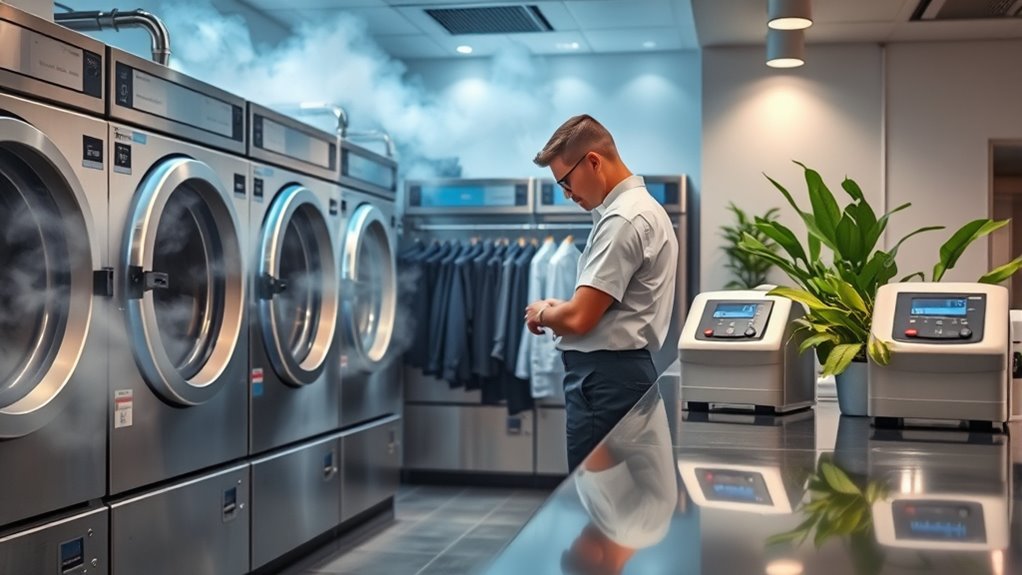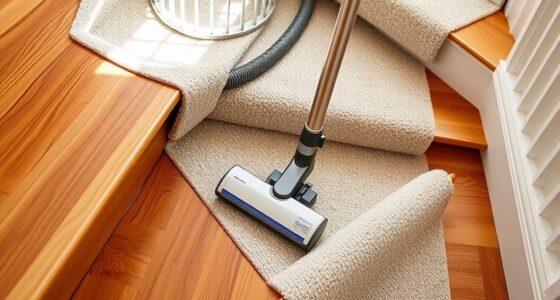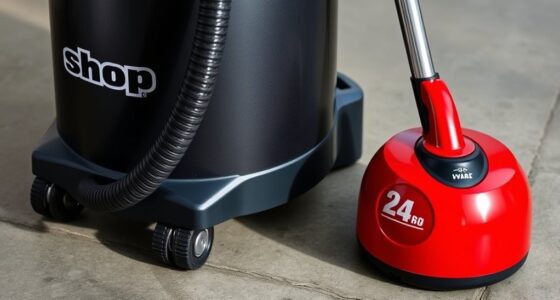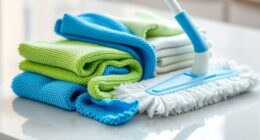Water-saving cleaning methods like dry cleaning, steam cleaning, and eco-friendly tools help you cut water and energy use while still getting your spaces sparkling. Dry cleaning uses special solvents to clean without much water, and steam cleaning loosens dirt with high-temperature vapor, reducing wastewater. Eco-friendly tools such as microfiber cloths trap dirt efficiently with minimal moisture. Keep exploring to discover more smart techniques that save resources and protect the environment.
Key Takeaways
- Dry cleaning uses specialized solvents and eco-friendly detergents to effectively clean with significantly less water than traditional methods.
- Steam cleaning employs high-temperature steam to loosen dirt and eliminate germs, reducing runoff and wastewater.
- Water-saving tools like microfiber cloths minimize water and chemical use while maintaining cleaning efficiency.
- Modern appliances with water-saving cycles and sensors optimize water and energy use during laundry and dishwashing.
- Implementing tailored cleaning routines and eco-friendly practices further reduces water consumption across various cleaning tasks.
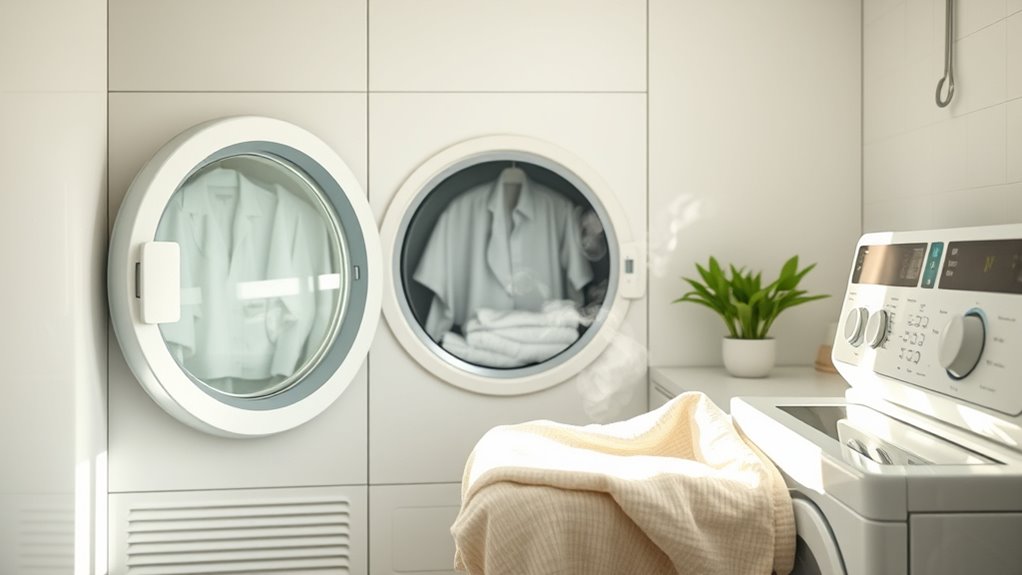
Cleaning often consumes more water than we realize, but you can make a difference by adopting water-saving methods. One effective approach is exploring dry cleaning options, which substantially reduce water use compared to traditional methods. Dry cleaning employs specialized solvents and eco friendly detergents that clean clothes effectively without soaking them in water. This not only conserves water but also minimizes wastewater production and energy consumption. When choosing dry cleaning services, look for those that prioritize energy efficient equipment, which further reduces environmental impact. Modern dry cleaning machines are designed to operate with less water and electricity, aligning with sustainable practices. Additionally, some dry cleaning companies utilize environmentally friendly solvents that further lessen chemical and water use.
Dry cleaning reduces water use and energy consumption with eco friendly solvents and efficient equipment.
Steam cleaning presents another excellent water-saving alternative. Instead of using copious amounts of water, steam cleaning utilizes high-temperature steam to loosen dirt, kill germs, and remove stains. This method is popular for cleaning carpets, upholstery, and hard surfaces. Since it uses less water, it results in less runoff and wastewater. Additionally, steam cleaning often requires fewer chemical agents, especially when combined with eco friendly detergents, making it a safer choice for your home and the environment. Investing in steam cleaning equipment that is energy efficient also helps you reduce electricity use, making your cleaning routine more sustainable.
You can also incorporate other water-saving methods like using microfiber cloths and mops. These fabrics trap dirt effectively with minimal moisture, reducing the need for frequent rinsing and water waste. When combined with eco friendly detergents, microfiber cleaning becomes even more environmentally friendly. Furthermore, adopting cleaning tools that are designed for efficiency means you use less product and water per task, saving resources over time.
Another practical step is to optimize your washing machine and dishwasher usage. Select models that are energy efficient and have water-saving cycles. Modern appliances often feature sensors that adjust water levels based on load size, preventing unnecessary water use. By running full loads and choosing eco-friendly detergent options, you maximize each wash’s efficiency. This reduces both water and energy consumption, aligning your cleaning practices with sustainability goals. Being mindful of dog breeds and their specific grooming needs can also help you tailor your cleaning routines to reduce water use even further.
Frequently Asked Questions
How Do Water-Saving Methods Compare in Cleaning Effectiveness?
Water-saving methods can be quite effective, but their cleaning efficiency varies. You might find that they better preserve fabrics, reducing wear and tear over time. However, stain removal efficiency may sometimes be slightly lower compared to traditional methods, especially for stubborn stains. Still, by choosing the right water-saving approach, you can balance fabric preservation with good cleaning results, making it a smart choice for eco-conscious laundry routines.
Are Water-Saving Cleaning Methods Suitable for All Fabric Types?
You might think you can clean every fabric with water-saving methods, but that’s like putting a square peg in a round hole. These methods suit delicate fabrics, but for heavy-duty or stain-prone materials, they may not deliver peak stain removal or fabric compatibility. Always check fabric labels and test small areas first. When used correctly, water-saving methods can keep your clothes fresh without compromising their integrity.
What Are the Environmental Benefits of Water-Saving Cleaning Techniques?
Water-saving cleaning techniques reduce your environmental impact by conserving water and lowering energy use. You’ll help protect water resources, decrease pollution, and cut down on greenhouse gas emissions associated with water treatment and heating. By choosing these methods, you actively support sustainable practices and promote a healthier planet. Your efforts in water conservation make a meaningful difference, contributing to a more eco-friendly future for everyone.
How Often Should Water-Saving Cleaning Methods Be Used?
You should use water-saving cleaning methods according to your cleaning schedules and frequency guidelines, typically once a week or as needed for routine maintenance. For high-traffic areas or when spills occur, increase the frequency to keep things hygienic without wasting water. Regular use helps maintain cleanliness while reducing environmental impact, so adapt your schedule based on usage levels and specific cleaning needs to maximize efficiency and sustainability.
Do Water-Saving Methods Cost More Than Traditional Cleaning?
Think of water-saving methods as a savvy shopper choosing quality over quantity. They often cost more upfront due to specialized equipment and eco-friendly products, but you save in the long run. The cost comparison depends on your preferences; if you value sustainability and reducing water use, you’re willing to pay a little extra. Ultimately, these methods align with customer preferences for eco-conscious choices, making them worthwhile investments.
Conclusion
Think of water-saving cleaning methods as your secret toolkit—powerful yet gentle, like a gust of fresh air in a crowded room. By choosing dry cleaning, steam cleaning, and other eco-friendly techniques, you’re not just tidying up; you’re helping preserve the precious resource that keeps our planet thriving. Every small step you take acts as a ripple, transforming your routine into a wave of positive change. Together, we can clean smarter and greener for a brighter future.
